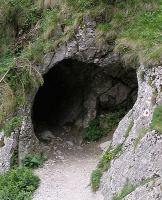When I was a young man I would sometimes visit the city dump with my father as he disposed of a load of trash. This was before the dump was regulated or supervised, and one could wander around and collect items of interest to a young boy. I often wondered where the various things came from and what they had meant in someones life. One might guess, but you could never know the whole picture, only an inferred imagining of the article's importance in an individual life.
This is a lot like archaeology. As one investigates the ruins and debris of a long dead culture, remnants of daily life are found -- shards of pottery, crumbling walls, or decaying grave sites. What can one know from such meager clues. Inferences can be made of course, but few clues of the feelings, thoughts or personalities of those ancient ones can be known. If only they had left a written record of their lives and activities so we could have a better understanding.
Fortunately, in some cases, we do have written records to clarify the shadowy archaeological finds, but to often these accounts are disregarded or ignored as being of no worth. Sadly, the Holy Scriptures are often relegated to this dust bin of history. The scientific world regards them as myth, or unsubstantiated legend, and won't even consider the clues they provide to the past. In addition, there are many legends and oral histories still alive among the descendants of the ancients, but too often the researchers regard these as unreliable or tainted, so we are unable to benefit from the kernels of truth found therein.
 |
| Amarna Tablet From Wikipedia |
I was reminded of this conundrum recently while reading an article from the Biblical Archaeology Review. The article was entitled The Trowel vs. the Text and related conflicting accounts between some recent finds of written records and previous archaeological findings. It brings up the question, which is more reliable, the archaeology or the written record? If we had a written record of an archaeological site, would it corroborate the researcher's findings?
This article centered around the discovery of the Amarna Tablets. These are inscribed clay tablets, discovered south of Cairo in 1887, not by professional archaeologists, but by a poor Bedouin woman. These tablets are written in Akkadian cuneiform and contain the official correspondence between the Egyptian king, his subjects, and his outlying domains. They were written circa 1400 BC.
Over the years hundreds of these tablets were discovered by the Bedouin who tried to sell them to whoever might be interested, without much success. Many were broken or lost over time. Years later several museums finally noticed the tablets and purchased some of them. When they were finally translated, they were found to contain much valuable historical information. Unfortunately, much of this information conflicted with previous findings of archaeological studies in the area. The archaeology only revealed part of the truth.
Some examples from the article:
Biblical accounts suggest that Canaan was heavily populated during this time period (1500-1150 BC). However, archaeological studies only found evidence of a sparse population. The Amarna Tablets support the Biblical account describing a thriving and large population.
Jerusalem of this time period should have been a large, thriving, fortified city. Archaeological studies have only found meager remains of what they felt was a small settlement (and a Canaanite one at that). The Amarna Tablets reveal the large and populous Jewish city described in the Bible.
Archaeological studies of the Canaanite city of Shechem found a medium sized royal stronghold, which was not particularly important. The textual evidence from the tablets reveals a large, flourishing city, powerful and important, wielding considerable influence over the entire region.
Excavation at the site of Lachish produced only meager finds. The tablets speak of the city as the seat of three different rulers and was ranked alongside Gezer and Ashkelon as a regional power.
From the evidence uncovered, we would conclude that Gezer was at best, an unimportant city-state, yet the textual record indicates that it was one of the leading Canaanite city-states involved in important alliances with prominent regional governments.
From the evidence uncovered, we would conclude that Gezer was at best, an unimportant city-state, yet the textual record indicates that it was one of the leading Canaanite city-states involved in important alliances with prominent regional governments.
The northern Canaanite city of Megiddo is one of the most studied sites in the Mideast. The excavations have been rewarding and a rich archaeological record has been revealed. However, the archaeologists have concluded that the city was unwalled and unfortified during this time period. On the other hand, the tablets describe this city as heavily fortified and walled.
During this time period, Egypt ruled over Canaan and established six government centers in the conquered territory. They had extensive contact with the Canaanite rulers and their armies passed through, or were stationed in Canaan. Yet there has been very little archaeological evidence uncovered that would reveal an Egyptian presence there. Only the tablets reveal that these events did occur.
From these examples we can conclude that archaeological evidence is at best partial and fragmentary. When we read an archaeological study, it is not safe to assume that we have the complete picture. Wherever possible, written records should be used alongside the scientific evidence. Where these records conflict, it is very likely that the written record is correct and should be given precedence. To give too much credence to partial evidence is to look through a glass darkly, to use Paul's phrase. The vision of the past is obscured.
